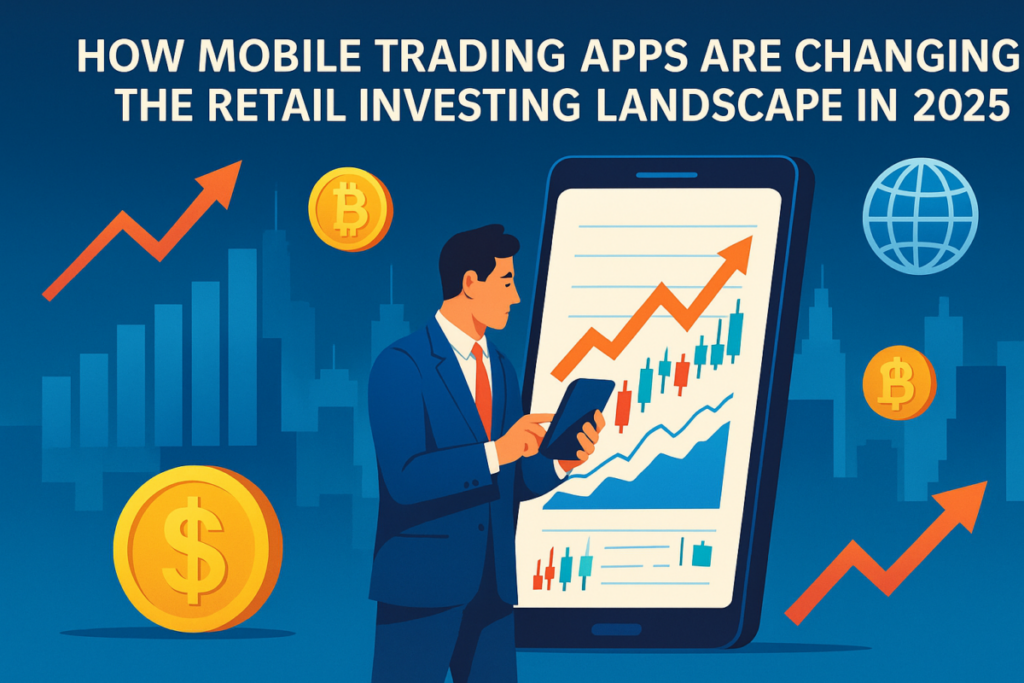Copyright Benzinga

The last decade has transformed retail investing, but no force has accelerated that change more than mobile trading apps. What was once a market dominated by full-service brokers, intimidating platforms, and high fees is now an open playing field where anyone with a smartphone and basic financial curiosity can participate. In 2025, mobile apps have shifted from passive investing portals to intelligent, data-driven platforms that offer real-time market insights, fractional trading, social investing, AI-powered analysis, and near-instant execution speeds. The revolution is no longer about access — it's about empowerment. A Market Once Barred by Complexity and Cost Just 15 years ago, the average individual investor needed a desktop terminal, a brokerage account with high commission fees, and a steep learning curve to trade independently. Long wait times, delayed information, and slow execution were normal. Market participation was limited to those who could afford it — financially and educationally. But the explosion of fintech innovation opened the doors. Commission-free trading, low-cost brokerage models, online education, and simple user interfaces created a dramatic shift: investing became democratized. 2025: The Peak of Investor Accessibility In today's landscape, mobile apps are not secondary platforms — for millions, they are the only investing platform. The modern investor does not wait to get home to trade, research a stock, read a news alert, or watch market reaction. They pull out their phone, swipe, trade, analyze, and learn — instantly. A modern investing app offers: Real-time stock, crypto, and ETF prices One-tap order execution AI-driven alerts and news Market education libraries Push notifications for price movements Community discussion Robo-advisory and automated trading Complete portfolio tracking This level of automation and accessibility has shattered the idea that investing is reserved for experts. The retail investor boom continues — especially among younger generations. Fractional Trading: The Feature That Redefined Participation In the past, a stock like Amazon or Tesla priced at hundreds or thousands of dollars per share meant many investors simply could not afford them. Fractional trading flipped the script. Now a user can invest $5, $10, or $100 into premium stocks without needing to buy a full share. Mobile platforms embraced fractional trading before traditional brokerages did. As a result, ownership of blue-chip stocks is no longer tied to wealth — it is tied to willingness. This shift matters because: New investors can diversify easily Small portfolios grow faster Young users start investing earlier Markets broaden globally In 2025, fractional ownership is not a bonus feature — it is an expectation. Real-Time Alerts: Information Without Delay Retail traders once depended on TV channels, news websites, or delayed platforms to learn what was happening in the market. Mobile apps changed that forever. Today, real-time push alerts notify users when: A price target hits Breaking news impacts a stock Insider trading or unusual volume appears Analyst upgrades or downgrades publish Crypto markets flash volatility Earnings reports drop This speed matters. Timely information equals smarter decision-making. For day traders and active investors, these alerts are not convenience — they are strategic advantage. AI Is Quietly Becoming the Retail Investor's Co-Pilot Artificial intelligence has become the hidden engine behind modern investing apps. Behind the interface, AI automation is analyzing patterns, scanning news sentiment, detecting volatility, and predicting market movement faster than any retail investor ever could. Key AI-driven features include: Automated trade signals Sentiment scoring from news headlines Pattern recognition and technical signal alerts Personalized investment suggestions Robo-advisory portfolio balancing Fraud detection and risk modeling AI does not guarantee perfect results, but it gives investors something they never had: institution-level intelligence at consumer-level accessibility. What hedge funds once built internally, retail apps now offer across a screen. The Rise of Social Investing Social investing — trading with a community — is now a dominant trend. Mobile trading apps allow users to: View expert traders' portfolios Follow strategies used by successful investors Share ideas and analysis Copy-trade successful strategies (in some regions) Younger investors especially value community. They don't want to invest alone — they want to learn from peers, influencers, educators, and analysts. This transparency builds financial confidence and reduces the fear of "not knowing enough." Education Built Into the Platform The number-one barrier to investing has always been knowledge, not money. Mobile apps now combine real-time trading with real-time learning. Most platforms include: Video tutorials Beginner guides Glossary of financial terms Visual charts simplified for non-experts Risk warnings for volatile assets Practice trading with virtual money Strategy-building courses This turns the platform into both a classroom and a marketplace — the user learns and invests simultaneously. Crypto Pushes Adoption Even Further Crypto trading accelerated the rise of mobile platforms. Unlike stocks, crypto operates 24/7 — which means mobile access became the standard, not the alternative. Even users who never bought a stock explored crypto through apps. Many of those same investors later expanded to equities and ETFs. Crypto-friendly mobile platforms now offer: Spot and futures trading Stablecoin purchases Staking rewards On-app wallets Price scanners On-chain data trackers Crypto made mobile platforms essential for day-to-day retail trading — in a way traditional markets never could. Security: The Silent Foundation As trading grew easier, security threats grew too. Today's finance apps embed advanced protection layers including: Multi-factor authentication Biometrics (face and fingerprint login) Fraud-pattern tracking End-to-end data encryption Regulatory compliance monitoring Trust is now a feature. A mobile app that cannot ensure safety simply cannot survive. Zero-Commission Trading: The Game-Changer Commission-free trading changed retail investing forever. Initially viewed as a marketing tactic, zero-commission models turned into a global standard. The impact was massive: More frequent trades Younger user adoption Shift away from traditional brokers Increased liquidity Today, users expect: Free stock trading Free ETF trading Low-cost crypto trading No minimum balances The platforms that failed to adapt faded from relevance. The Psychological Shift: Investors Have Grown Fearless Mobile apps didn't just change access — they changed mindset. Retail traders today are more confident, more experimental, and more educated than previous generations. The fear barrier is gone. People are no longer intimidated by Wall Street; they participate in it. Investing is now part of everyday life: Buying fractional shares while commuting Checking earnings alerts during lunch Researching stocks while watching market news Setting up automatic investments before age 25 This generational shift will permanently influence global markets. Going Global: Geography No Longer Matters Mobile trading apps erased borders. Investors in India can buy U.S. stocks. Users in Europe trade crypto on Asian exchanges. A student in Brazil can invest in fractional shares of the S&P 500. This global integration: Increases liquidity Expands access to foreign markets Improves financial participation Connects investors worldwide Markets are no longer local — they are handheld and global. The Future: Hyper-Personalized Investing By 2030, mobile trading apps are expected to become even more predictive and personalized. Investors will likely see: AI-built portfolios based on spending habits Personalized tax-loss harvesting Predictive risk scoring Deep behavioral analytics Voice-activated trading Sentiment-based social feeds Investing will feel less like using a tool and more like interacting with a smart partner that understands financial goals, personality, and risk preference. Conclusion The retail investing revolution is not coming — it has already arrived. Mobile trading apps have dismantled historical barriers of cost, education, and complexity. They have created a financial world where every individual — regardless of background — can own stocks, crypto, ETFs, or global assets with just a smartphone. As technology continues to evolve, mobile apps will push investing closer to automation, personalization, and democratized wealth-building. The smartphone is now the new trading floor, and millions of people are participating in the market with a level of speed and sophistication once reserved for institutions. Any fintech startup that hopes to compete in this space must innovate quickly, adopt real-time data, and embrace AI-driven automation — which is why many companies now choose to hire mobile app developers with fintech expertise to meet rising user expectations.



